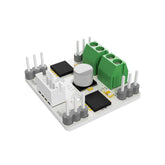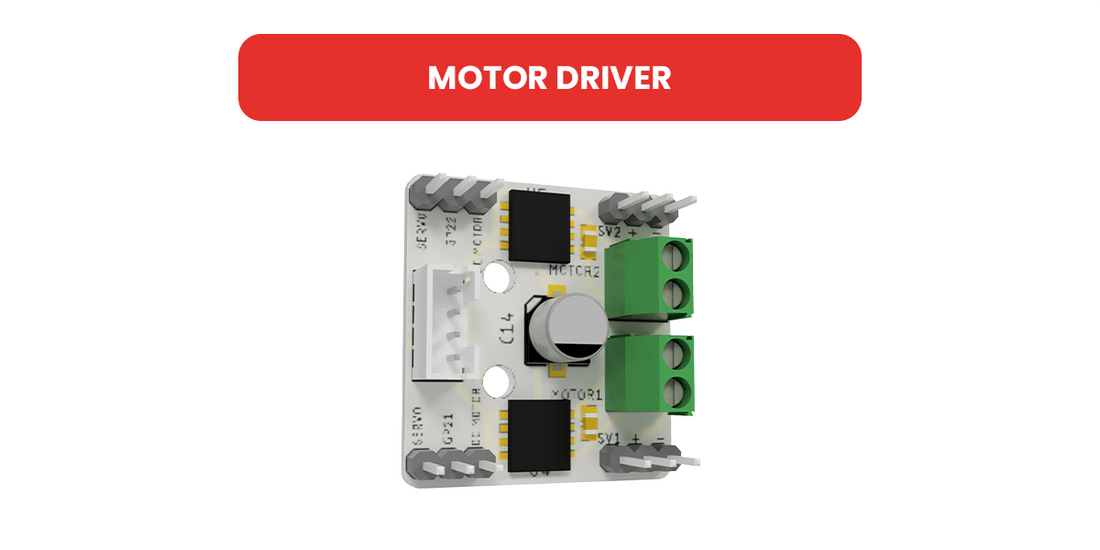A motor driver, also known as a control motor, is an electronic device or module that controls and manages the operation of an electric motor. It serves as an interface between a microcontroller or other control system and the motor itself, enabling precise control of the motor’s speed, direction, and other parameters. Motor drivers are commonly used in various applications, including robotics, automation, automotive systems, and industrial machinery.
This module comprises two servo and two DC motor drivers. The motors are devoid of + and – terminals, thereby eliminating the need to be concerned about reverse connections. The direction of the motors changes based on the wiring.
Types of Motor Driver Module
DC and servo motor drivers are indeed types of motor drivers:
Servo Motor Drivers: Regulate the position, speed, and torque of servo motors.
DC Motor Drivers: Control the speed and direction of DC motors.What is Servo Motor?
Servo motors are renowned for their precision in controlling the position or angle of an object. They are ideal for tasks such as storing objects in a specific position or carrying out operations for a specified duration. Servo motors typically incorporate a feedback mechanism that helps control and adjust the motor’s current position or speed as needed. They can generate high torque (rotational force) and have short response times. These motors are commonly used in various industrial applications that require precise control and positioning of electromechanical devices.
The following are some examples of servo motor applications:
- Robotic Projects: Servo motors can be used to control the movement of a robot’s arms and legs, allowing for more versatile functionality.
- Camera Tracking Systems: In Raspberry Pi or Arduino-based projects, servo motor-mounted cameras can be used to track objects and people, making them useful for automatic tracking systems.
- Automation Projects: They can be used for tasks such as opening and closing curtains, controlling doors, and holding objects in specific positions in home automation and workshop automation projects.
- RC Vehicles (Remote Control): Arduino or Raspberry Pi-based remote-controlled vehicles use servo motors to steer the wheels and control the direction.
- Education and Learning: They are excellent tools for students learning about electronics and mechatronics, offering a wide range of learning opportunities from basic electronic projects to complex robotics projects.
What is DC Motor?
DC motors are electromechanical devices powered by direct current (DC). They rotate a shaft by passing an electric current through them. The rotational movement of these motors is useful for various applications, and they can rotate in both forward and reverse directions. In many applications, this bidirectional rotation is used to control the desired movement direction. The speed of a DC motor can be adjusted by controlling the applied voltage or current, making them suitable for applications requiring variable speeds. DC motors come in different sizes and power levels, ranging from small toy vehicles to industrial machine drive systems.
Here are some example applications of DC motors:
- Robotic Projects: They can be used to control the wheels and arms of robots, making them suitable for creating your own robots or adding motion capabilities to existing ones.
- Vehicle Control: In projects created with Arduino or Raspberry Pi, They can be used to control the movement of toy vehicles and miniature cars. These motors are suitable for remote-controlled or autonomous vehicle production.
- Conveyor Belts: They can be used to move conveyor belts in product transportation or sorting systems. This is crucial for industrial automation projects.
- Camera Tracking Systems: Raspberry Pi-based projects can use DC motors to direct the camera in a specific direction for object tracking or following.
- Home Automation: They can control curtain and blind systems, open and close doors, and manage garage doors in home automation projects. This is perfect for home automation projects.
If you want to experience the motor driver on PicoBricks Simulator, you can click here!
DC Motor Driver Circuit
Here is the dc motor driver circuit we have prepared for you:

FAQ
What is the role of motor driver?
The role of a motor driver is to control and regulate the operation of a motor, adjusting its speed, direction, and torque based on input signals.
Is a motor driver an amplifier?
Yes, a motor driver can be considered an amplifier as it takes low-power control signals and amplifies them to drive a motor with higher power.
What is inside a motor driver?
Inside a motor driver, you typically find power transistors (MOSFETs or BJTs), control circuits, and often protective features like current sensing and thermal shutdown mechanisms.





